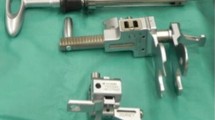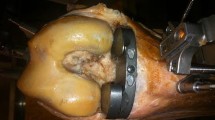Abstract
Navigation has been developed to help surgeons install implants more accurately and reproducibly; at the same time, this tool is able to record quantitative information such as joint range of motion, laxity and kinematics intra-operatively. As for standard surgery, two strategies are possible to achieve either femoral component rotation or overall prosthetic alignment: a measured gap resection approach, in which bone landmarks are used to guide resections equal to the distal and posterior thickness of the femoral component, or a gap-balancing technique, in which equal collateral ligament tension in flexion and extension is tried to find before as a guide to final bone cuts. The purpose of this paper is to compare the two different methods in a 67 patients group submitted to the same procedure using mobile-bearing (MB) prosthesis in order to analyse the effect of both techniques on joint line maintenance, axial limb restoration and components position. The gap group (GG) consists of 31 patients in whom the arthroplasty was performed using a navigated gap-balancing technique. The measured group (MG) consists of 36 patients in whom a computer-assisted measured resection technique was used. The results of imaging and the number of outliers were not statistically different (P = 0.56) for the mechanical axis and prosthetic positioning between the two groups. The gap technique showed a statistically significant alteration of the post-operative value when compared with the measured resection technique, (P = 0.036). The mean elevation of the joint line was 4.09 mm for the GG and 3.50 mm in the MG.



Similar content being viewed by others
References
Freeman MAR, Samuelson KM, Levack B, De Alencar PGC (1986) Knee arthroplasty at the London hospital: 1975–1984. Clin Orthop 205:12–20
Insall J, Ranawat CS, Scott WN, Walker P (1976) Total condylar knee replacement: preliminary report. Clin Orthop Relat Res. 120:149–154
Boldt JG, Stiehl JB, Munzinger U, Beverland D, Keblish PA (2006) Femoral component rotation in mobile-bearing total knee arthroplasty. Knee 13:284–289
Hungerford DS, Kenna RV, Krackow KA (1982) The porous coated anatomic total knee. Orthop Clin North Am 13(1):103–122
Laskin RS, Beksac B, Phongjunakorn A, Pittors K, Davis J, Shim JC, Pavlov H, Petersen M (2004) Minimally invasive total knee replacement through a mini mid vastus incision. An outcome study. Clin Orthop Relat Res 428:74–81
Bathis H, Prlick L, Tingart M, Luring C, Perlick C, Grifka J (2004) Radiological results of image-based and non image based computer-assisted total knee arthroplasty. Int Orthop 28:87–90
Figgie HE III, Goldberg VM, Heiple KG, Moller HS III, Gordon NH (1986) The influence of tibial-patellofemoral location on function of the knee in patients with the posterior stabilized condylar knee prosthesis. J Bone Joint Surg Am 68:1035–1040
Martino F, Solarino M (1998) Radiologia scheletrica: tecnica radiografica e misurazioni. Idelson-Gnocchi, Napoli
Bland LM, Altman DG (1986) Statistical methods for assessing agreement two methods of clinical measurement. Lancet 8(8476):307–310
Partington PF, Sawhney J, Rorabeck CH (1999) Joint line restoration after revision total knee arthroplasty. Clin Orthop 367:165–171
Prakash U, Wigderowitz CA, McGurty DW, Rowley DI (2001) Computerised measurement of tibiofemoral alignment. J Bone Joint Surg [Br] 83:819–824
Servien E, Viskontas D, Giuffrè BM, Coolican MR, Parker DA (2008) Reliability of bony landmarks for restoration of the joint line in revision knee arthroplasty. Knee Surg Sports Traumatol Arthrosc 16:263–269
Tigani D, Sabbioni G, Ben Ayad R, Filanti M, Rani N, Del Piccolo N (2010) Comparison between two computers assisted total knee arthroplasty: gap balancing verses measured resection technique. Knee Surg Sports Traumatol Arthrosc 18:1304–1310
Selvarajah E, Hooper G (2009) Restoration of the joint line in total knee arthroplasty. J Arthroplasty 7:1099–1102
Matsueda M, Gengerke TR, Murphy M, Lew WD, Gustilo RB (1999) Soft tissue release in total knee arthroplasty: cadaveric study using knees without deformities. Clin Orthop 366:264–273
Cope MR, O’Brien BS, Nanu AM (2002) The influence of the posterior cruciate ligament in the maintenance of joint line in primary total knee arthroplasty a radiologic study. J Arthroplasty 17(2):206–208
Acknowledgments
No funding or external support was received by any of the authors in support of or in any relationship to the study. We would like to thank Ms. Elettra Pignotti for interpretation of the data and statistical support.
Conflict of interest
The authors are not aware of any conflict of interests arising from the publication of the manuscript.
Author information
Authors and Affiliations
Corresponding author
Rights and permissions
About this article
Cite this article
Sabbioni, G., Rani, N., Del Piccolo, N. et al. Gap balancing versus measured resection technique using a mobile-bearing prosthesis in computer-assisted surgery. Musculoskelet Surg 95, 25–30 (2011). https://doi.org/10.1007/s12306-011-0110-2
Received:
Accepted:
Published:
Issue Date:
DOI: https://doi.org/10.1007/s12306-011-0110-2




